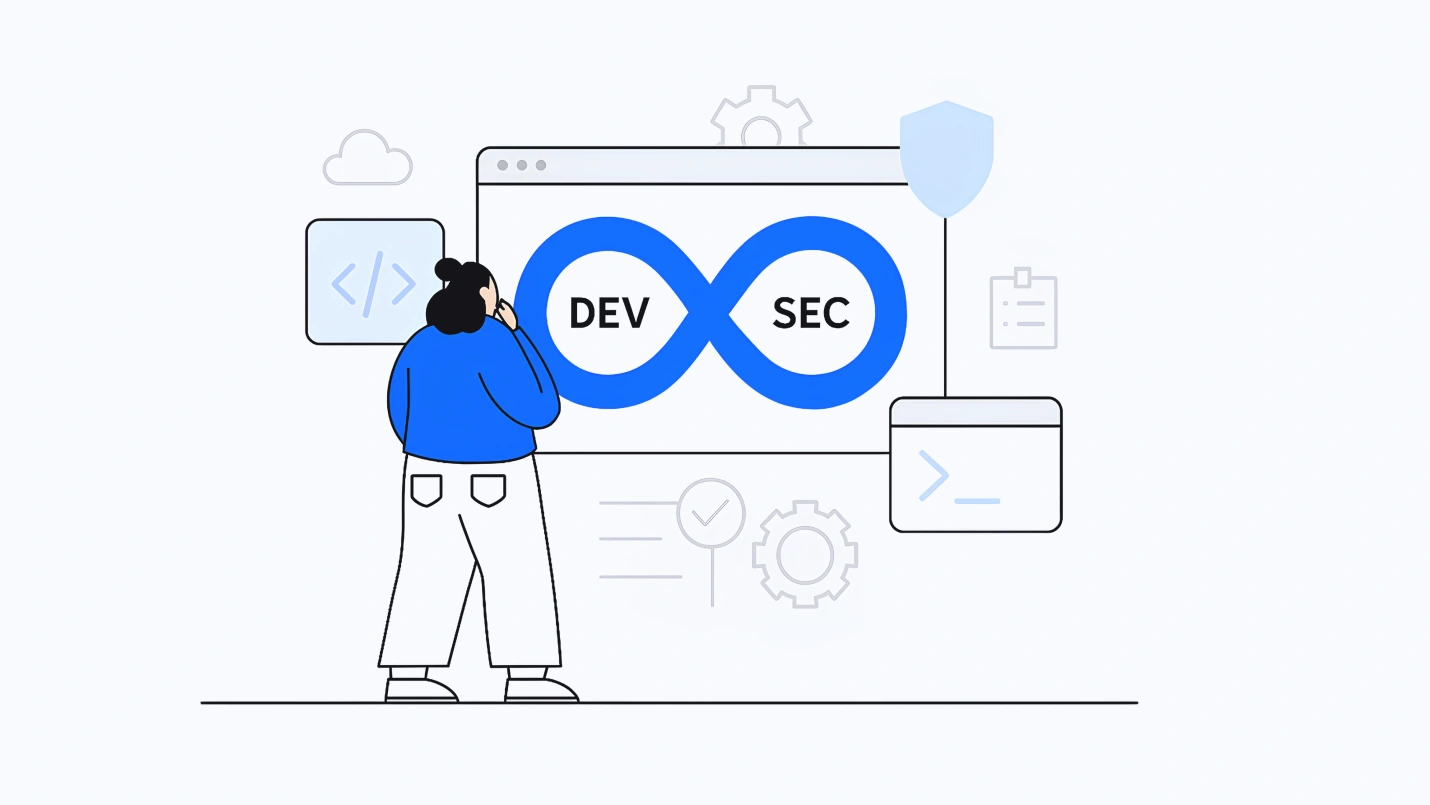Summary: DevSecOps is a management approach that combines application development, security, operations, and infrastructure as a code (IaaS) in an automated, continuous delivery cycle. The article below discusses the applications of DevSecOps and how it helps detect and fix vulnerabilities before they reach production or release.
The DevSecOps market will grow to USD 5.9 billion by 2023, at a CAGR of 31.2%.– Market Research Report
Application Security Testing has been traditionally performed at the end of the development process, usually as an afterthought.
The reason? The urgency to push a product to the market at the right time, as soon as possible.
“Just ship it” has become a cliche in the IT product development cycle. While shipping as fast as possible can give a business an edge over the competition, there is one thing that is usually handled with levity: Security.
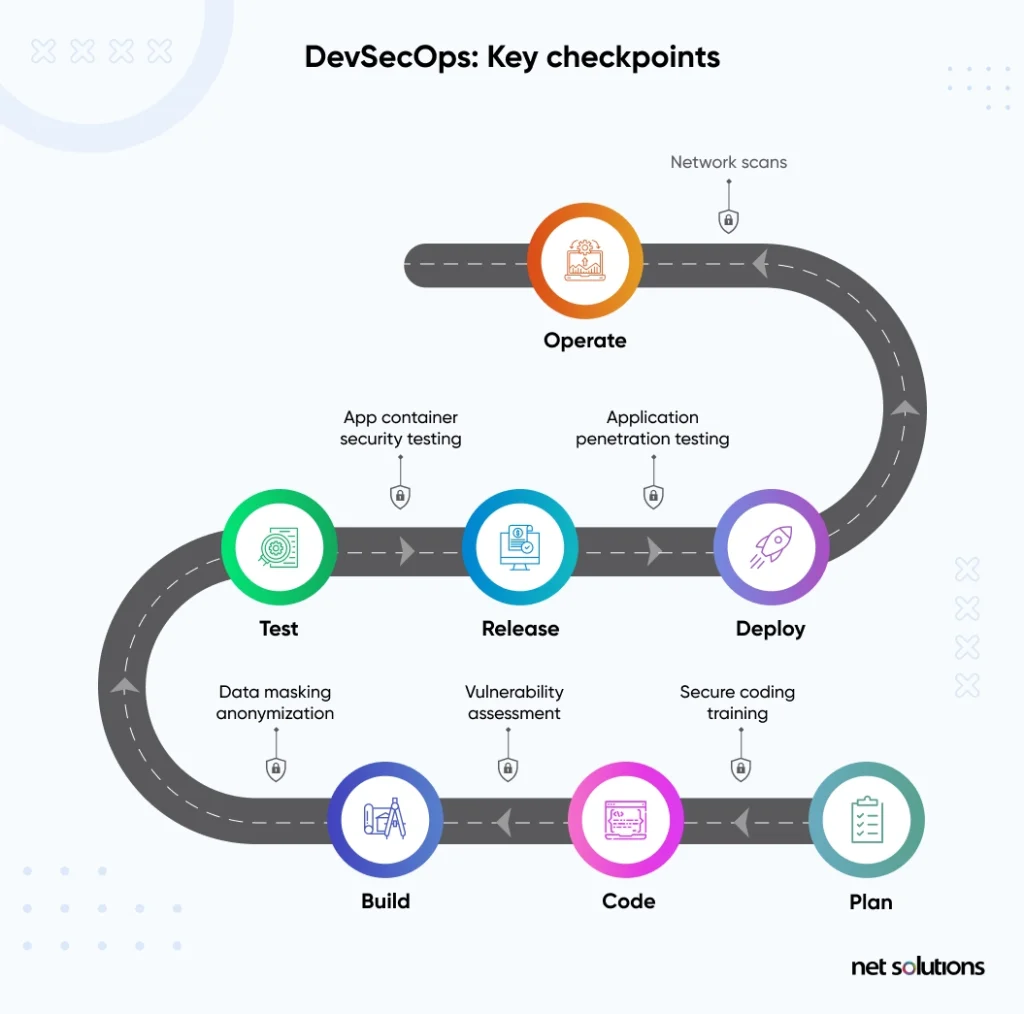
Objectives of DevSecops and why you need it
The primary goal of DevSecOps is to automate, monitor, and apply security throughout the software Development lifecycle, which includes planning, developing, building, testing, releasing, delivering, deploying, operating, and monitoring. Using security at every stage of the software development process enables continuous integration, lowering compliance costs and delivering software faster.
DevSecOps implies that every employee and team is responsible for security from the start, and they must make decisions quickly and implement them without jeopardizing security.
Application Security Testing has been traditionally performed at the end of the development process, usually as an afterthought.
A report by Cybersecurity Ventures reveals that cybercrime will cost the world $6 trillion annually in damages in another two years.
What problems does DevSecOps solve?
While security is critical, it is frequently introduced only in the final stages of software development. Organizations must prioritize security so that consumers can trust the apps they use. Below are some of the problems that DevSecOps solve:
1. Velocity
Product development and distribution would be safer and faster if you took security precautions. DevSecOps enables businesses to rapidly bring new applications to market while ensuring that business requirements are met or exceeded.
2. Security conscientious
Businesses get sued and have their brand image harmed due to security flaws in their software, jeopardizing customer information. DevSecOps ensures that security is a norm rather than an afterthought, guaranteeing that developers always develop with application security in mind.
3. Improved software
By securing the container environment, businesses can avoid vulnerabilities that arise when security is introduced late in the process. This adds value throughout the application’s lifecycle. Integrating security with software development lifecycle tools, for example, at the beginning of the development phase, allows for registry image scanning, digital signing, and code analysis to ensure code integrity, avoiding costly issues later on.
Benefits of the DevSecOps approach
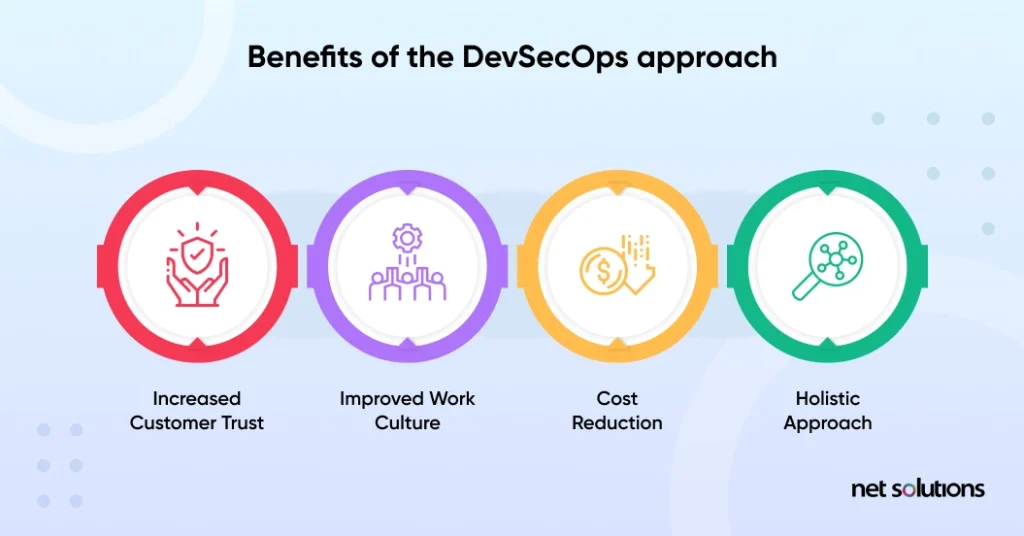
Now that we are clear on the problems that DevSecOps can help us with, we can discuss the right approach to work with DevSecOps. Following are the benefits of incorporating the DevSecOps strategy into your business model:
1. Increased customer trust
Customers may not be able to tell if a company is implementing a DevSecOps strategy initially, but it becomes evident over time. Consistent security breaches cause a product to lose many, if not all, of its users since nobody trusts a product with breached security.
2. Improved work culture
When everybody in the organization is on the same page concerning the company’s stance on security, it becomes easier to communicate. Teamwork is more effective when everybody understands the core values of a company or a product.
3. Cost reduction
Implementing the DevSecOps flow helps reduce the cost as the security issues get detected and fixed early during the development phases, along with increasing the speed of product delivery.
4. Holistic approach
The DevSecOps pipeline and application remain secure with integrated frameworks. This eventually helps build an end-to-end and comprehensive defense throughout the production environment.
What is DevSecOps methodology?
Development + Security + Operations, in short, DevSecOps, is the philosophy of integrating automated security processes into an agile IT and DevOps framework to merge two different goals—speed of delivery and secure code—into a single seamless, streamlined, and transparent process.
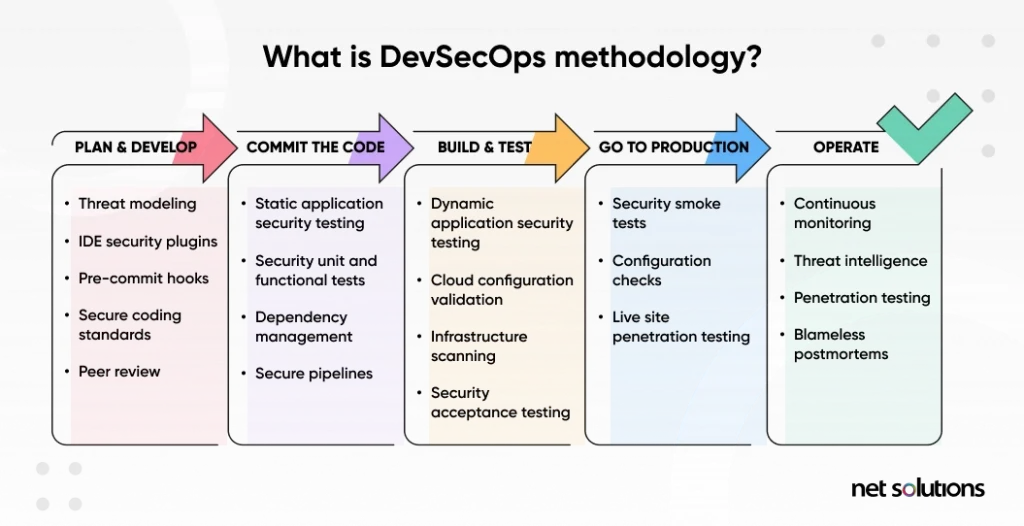
Speed and security in code delivery might seem an oxymoron for most organizations, but the DevSecOps approach aims to change that outlook.
What are the key components of DevSecOps?
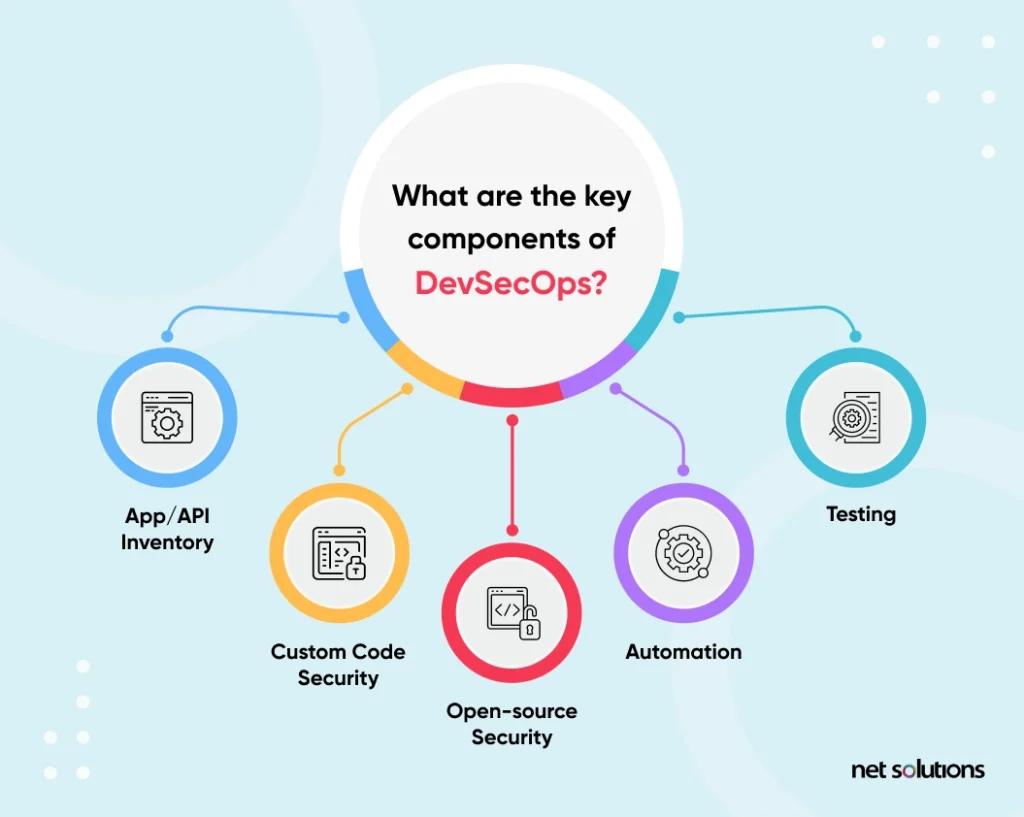
One thing is for sure, maintaining security is indispensable, and treating it as an afterthought is only decelerating your progress. And for your business to promise security at every step, you must approach DevSevOps through these important components:
1. App/API inventory
While inventorying everything is essential, it does not make anything more secure. Automate the discovery, profiling, and continuous code monitoring across the portfolio. The pragmatic approach to API security is to get close to the code, instrumenting every stack layer. Some products work at the network, host, application, container, and API layers.
2. Custom code security
Throughout development, testing, and operations, continuously monitor software for vulnerabilities. Deliver code frequently so that vulnerabilities are quickly identified with each code update.
Security teams contribute by first becoming acquainted with DevOps practices and incorporating them into security, such as delivering security capabilities in small, frequent installments and automating security tasks whenever possible. In turn, developers must educate themselves on security standards, demands, threat awareness, and tools.
3. Open-source security
Open source software (OSS) frequently contains security flaws; a comprehensive security strategy includes a solution that tracks OSS libraries and reports vulnerabilities and license violations.
4. Automation
Automation is an essential aspect of a successful DevSecOps initiative. It enables security measures to be integrated into the development process and ensures that security does not become a burden on development teams. Security testing and analysis can be integrated into CI/CD pipelines to deliver secure software while not stifling innovation and development workflows.
5. Testing
Security tests are performed as the final step before product release, but testing should ideally take place throughout the entire development process. Static application security testing (SAST), dynamic application security testing (DAST), and less common but equally essential techniques like penetration testing, Red Teaming, and Threat Modeling are all effective testing regimens. These latter approaches can be helpful because they approach code from a hacker’s perspective without disrupting the production environment.
DevSecOps challenges
Every successful security plan rests on three pillars: People, Processes, and Technology.
The DevSecOps approach is no different. Its successful implementation relies on better collaboration between Development, Security, and Operations. Nonetheless, a rift between the DevSecOps security and development teams is inevitable in most cases while implementing this strategy.
Businesses trying to adapt DevSecOps often face collaboration issues, along with the following challenges:
1. People Challenge
Any change begins with people; in the case of DevOps solutions, people are the starting point of its implementation. It’s already a challenge to form a cohesive team of Dev and Ops, and adding a third team of security, known to work in silos, amplifies the complexity.
2. Process Challenge
Speed, Security, and Quality are the top DevSecOps tools defining an ideal product. Since the advent of the product development environment, security has come to an end of development. Thus, getting security to adapt to the DevOps principles adds to the challenge.
3. Technology Challenge
Security testing tools and their integration in CI/CD pipeline are vital for DevSecOps success. Shifting the left approach, using tools to cover all possible security tests, attempting as much no-touch automation as possible, and using AI capabilities will be essential for DevSecOps’ success.
With DevSecOps, this traditional and siloed mindset of a project manager gets broken down, and it almost becomes impossible for a threat to penetrate the application.
DevSecOps best practices
Implementing the DevSecOps strategy is an elaborate process. While there are no standard textbook steps that can help serve as a roadmap, here’s a list of best practices that every business should reflect on while embarking upon a DevSecOps journey:
1. Enforce frequent security checks
All software dependencies should be checked frequently, as 78% of security vulnerabilities in software result from indirect dependencies: open-source dependencies. It is common to find that these dependencies become obsolete after a while, thereby increasing the chances of a security vulnerability.
2. Use security dashboards
63% of businesses do not have an effective way to track threats, and security dashboards can help here. Dashboards provide insights from the available data, making it easier to discover attempts to breach security. With the help of dashboards, it becomes simpler to set up real-time automatic alerts and responses when there is an imminent threat.
3. Empower Developers with regular security training
Every developer tries to make the software feature-rich while missing the code’s security implications that make the product extremely vulnerable. To ingrain the culture of a security-first approach in product development, it’s crucial to empower the developers with regular security training regularly.
DevSecOps tools
DevSecOps tools are essential because security must be automated and tightly integrated with the CI/CD pipeline in a speedy DevOps environment. These tools serve two purposes. The first goal is to reduce risk in development pipelines while maintaining velocity by detecting and correcting security vulnerabilities through comprehensive security testing. The second goal is to assist security teams in monitoring development project security without manual review and approval.
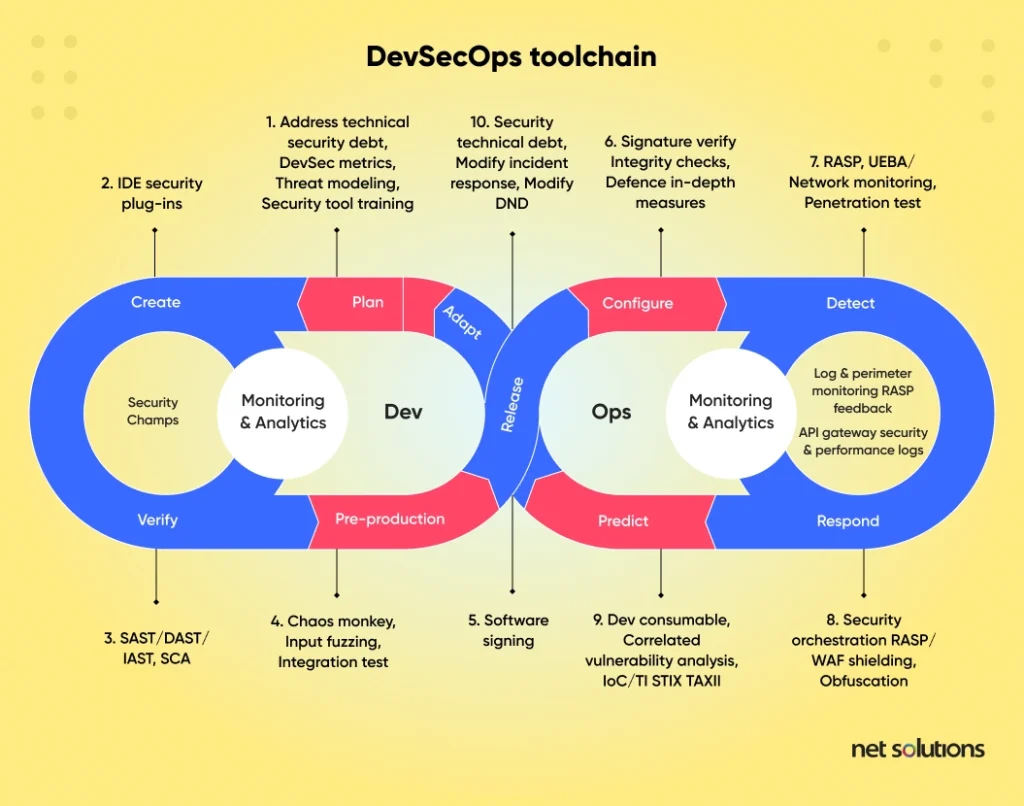
1. Checkmarx
Checkmarx is a market leader in an essential aspect of DevSecOps: application security (AppSec) testing. The Checkmarx Application Security Testing (AST) platform provides integrated security for the entire software development lifecycle as businesses manage containers, IaC, custom code, and open-source components.
2. SonarQube
A static code analysis tool, SonarQube is free and open-source, with top-quality versions ready to expand on the free version’s basic but operational capabilities.
3. Invicti Security
With its dynamic and interactive scanning, Invicti secures over 800,000 web applications in 115 countries, providing administrators with an accurate picture of vulnerabilities and remediation efforts. Invicti prioritizes security testing automation to create long-term SDLC processes for scaling operations.
4. Snyk
The cybersecurity vendor provides documentation for using its CLI and API and options for deployment and integrations from existing CI/CD pipelines. Prospective customers can try Snyk for free or select one of three commercial plans: Team, Business, or Enterprise.
5. Aqua Security
Aqua Security provides comprehensive DevOps lifecycle protection. Kubernetes, dynamic threat analysis, serverless security, virtual machine, and container security are all part of the Aqua Platform’s growing list of critical cybersecurity functions.
Frequently Asked Questions
DevOps emphasizes application team collaboration throughout the app development and deployment process. The development and operations teams collaborate to implement common KPIs and tools. DevSecOps evolved from DevOps as development teams realized that the DevOps model did not address security concerns adequately. Rather than retrofitting security into the build, DevSecOps emerged as a way to integrate security management earlier in the development process.
Scanning repositories for security vulnerabilities, early threat modeling, security design reviews, static code analysis, code reviews, etc.
- Plan
- Build
- Test
- Deploy
- Operate, and
- Observe
To work successfully with DevOps teams, a DevSecOps engineer must thoroughly understand popular programming languages such as PHP, Java, JavaScript, Ruby, and Python. It is also necessary to be familiar with popular CI/CD tools such as Jenkins, GitLab CI/CD, CircleCI, Puppet, Chef, and Spinnaker.

